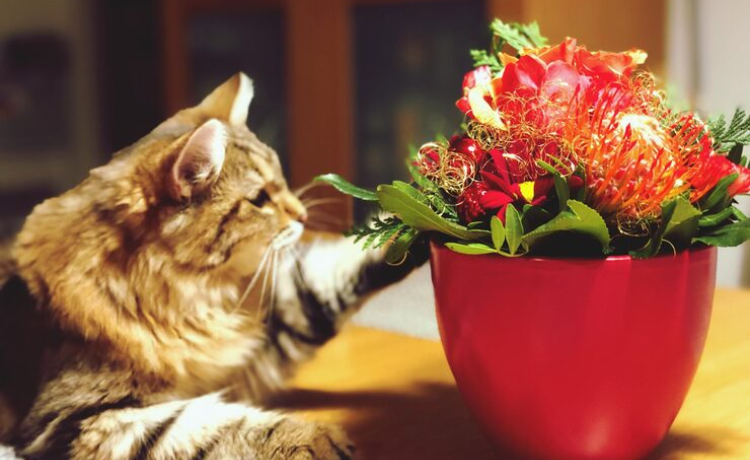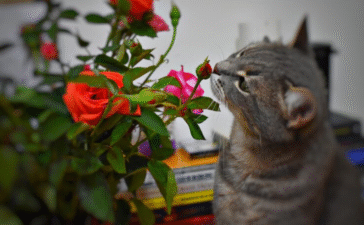Bringing flowers into your home can brighten up any room, but for cat owners, it introduces a serious question: is this bouquet safe for my curious feline? As a responsible pet parent, understanding what flowers are safe for cats and which are foes is essential for your cat’s health and safety. Many common decorative plants and flowers can be toxic, leading to severe health issues if ingested.
Cats are naturally inquisitive and may nibble on leaves or petals out of curiosity. Unfortunately, this can have dire consequences. According to the ASPCA Animal Poison Control Center, they receive thousands of calls each year related to pet poisonings, with plants being a common culprit. Ingesting a toxic flower can lead to symptoms ranging from mild stomach upset to severe organ damage or even death. This guide will walk you through the most common safe and toxic flowers, helping you create a beautiful and secure environment for your furry companion.
Common what flowers are safe for cats
Creating a pet-friendly home doesn’t mean you have to give up on beautiful floral arrangements. Many popular flowers are completely non-toxic to cats, allowing you to enjoy nature’s beauty without worry.
Roses
Roses are a classic symbol of love and beauty, and thankfully, they are considered safe for cats. If your cat decides to nibble on a rose petal or leaf, you don’t need to panic. The primary concern with roses is not toxicity but the physical harm from thorns. To keep your cat safe, simply remove the thorns from the stems before placing them in a vase. Keeping the bouquet on a high shelf or in a room your cat can’t access is also a great way to prevent any accidental pricks.
Gerbera Daisies
Vibrant and cheerful, Gerbera daisies are another excellent choice for cat owners. These colorful flowers are non-toxic to felines, making them a worry-free addition to your home décor. Their bright colors can liven up any space, and you can rest easy knowing that your curious cat won’t be harmed by sniffing or even tasting them. Gerbera daisies are a perfect example of how you can have both a stylish home and a safe pet.
Orchids
Orchids, particularly the popular Phalaenopsis variety, are one of the safest indoor plants for cats. These elegant and exotic flowers add a touch of sophistication to your home and are non-toxic to your furry friends. While there are thousands of orchid species, the ones commonly sold as houseplants are generally considered safe. As with any plant, it’s best to discourage your cat from making it a regular snack, but an occasional nibble is unlikely to cause any harm.
Sunflowers
With their large, sunny faces, sunflowers are a joyful and safe choice for homes with cats. These beautiful blooms are non-toxic, so you can place them in a vase without concern. When bringing sunflowers indoors, just be mindful of any pollen they might shed, as it can make a bit of a mess. In the garden, ensure that any pesticides used on the plants are pet-safe to avoid indirect exposure.
Snapdragons
Snapdragons are whimsical, colorful flowers that are also safe for cats. Their unique shape and vibrant hues make them a fun addition to any garden or bouquet. You can grow snapdragons in cat-friendly spaces without worrying about toxicity. They are a great way to add vertical interest to your garden beds while ensuring the area remains a safe playground for your pet.
Toxic and Harmful Flowers to Avoid Around Cats
While many flowers are harmless, some of the most popular bouquets contain plants that are extremely dangerous for cats. Awareness is the first step in prevention.
Lilies
Lilies are perhaps the most dangerous flower for cats. All parts of the lily plant—including the petals, leaves, stem, and even the pollen—are highly toxic. Ingesting just a small amount can lead to acute kidney failure and death. The Easter lily, tiger lily, and Asiatic lily are particularly hazardous. If you suspect your cat has come into contact with a lily, seek immediate veterinary care, as prompt treatment is crucial for survival.
Tulips and Daffodils
Tulips and daffodils are beautiful harbingers of spring, but they pose a significant threat to cats. The bulbs of these plants contain the highest concentration of toxins, but the flowers and leaves are also dangerous if ingested. Poisoning can cause intense gastrointestinal irritation, drooling, loss of appetite, and in severe cases, convulsions and cardiac abnormalities.
Chrysanthemums (Mums)
Commonly found in fall gardens and bouquets, chrysanthemums contain pyrethrins, which are toxic to cats. Ingestion can lead to symptoms like drooling, vomiting, diarrhea, and loss of coordination. While generally not as deadly as lilies, they can still cause significant discomfort and illness. It’s best to avoid having mums in your home or garden if you have cats.
Azaleas
Azaleas, part of the Rhododendron family, contain grayanotoxins that can disrupt nerve and muscle function in cats. Even a few leaves can cause serious issues like vomiting, diarrhea, weakness, and in severe cases, cardiac failure. These popular garden shrubs should be kept well out of your cat’s reach.
Oleander
Oleander is an incredibly toxic plant, and every part of it is dangerous. It contains cardiac glycosides, which can cause severe vomiting, a dangerous drop in heart rate, and can be fatal. Due to its extreme toxicity, oleander should never be present in a home or garden with cats or other pets.
How to Keep Your Cat Safe from Toxic Flowers
Protecting your cat is about being proactive. With a few simple strategies, you can enjoy flowers while keeping your pet safe from harm.
Choose Pet-Friendly Bouquets
When buying or receiving flowers, always choose varieties you know are cat-safe. If you’re unsure, ask your florist for a pet-friendly bouquet. Many florists are knowledgeable about plant toxicity and can help you select beautiful, safe arrangements. When in doubt, a quick search on the ASPCA’s plant list can provide peace of mind.
Indoor Plant Safety
Even with safe flowers, it’s a good practice to keep them out of your cat’s easy reach. Place vases on high shelves, in rooms your cat doesn’t frequent, or use hanging planters. This prevents your cat from developing a habit of chewing on plants and reduces the risk of them knocking over a vase.
Outdoor Garden Tips for Pet Owners
Creating a cat-friendly garden involves choosing non-toxic plants for cats and designing the space with safety in mind. Plant safe flowers like snapdragons, gerbera daisies, and sunflowers. You can also use raised garden beds or decorative fencing to create designated “cat-free” zones for plants you want to protect or that might be mildly irritating, even if non-toxic.
You would also like: “dog friendly sofa“
Symptoms of Flower Poisoning in Cats and What to Do
Knowing the signs of poisoning and acting quickly can save your cat’s life.
Common Symptoms of Toxic Flower Ingestion
If you suspect your cat has ingested a toxic flower, watch for symptoms such as vomiting, diarrhea, drooling, difficulty swallowing, lethargy, weakness, or loss of appetite. More severe signs include seizures, difficulty breathing, or collapse. If you notice any of these signs, it’s critical to act immediately.
When to Visit the Vet
Suspected poisoning is a medical emergency. Contact your veterinarian or an emergency animal hospital right away. Do not wait for symptoms to worsen. If possible, bring a sample of the plant your cat ingested to help the vet with diagnosis and treatment. Expect the vet to perform a physical exam, run blood tests, and administer treatments like induced vomiting or intravenous fluids.
Frequently Asked Questions (FAQs)
Are all types of lilies harmful to cats?
Yes, all true lilies (from the Lilium and Hemerocallis families) are extremely toxic to cats. This includes popular varieties like Easter, tiger, Asiatic, and daylilies. Even a small amount of pollen can cause fatal kidney failure. Calla lilies and peace lilies, while not true lilies, can cause oral irritation but are not as life-threatening. However, due to the extreme danger of true lilies, it’s safest to avoid all flowers with “lily” in their name.
Can I plant roses and gerbera daisies together in my garden if I have cats?
Absolutely. Both roses and gerbera daisies are non-toxic to cats, so planting them together in a garden is perfectly safe. It’s a great way to create a vibrant, beautiful, and pet-friendly outdoor space. Always ensure any fertilizers or pesticides used in your garden are also pet-safe.
What should I do if I think my cat has eaten a toxic flower?
If you suspect your cat has ingested any part of a toxic plant, contact your veterinarian or the ASPCA Animal Poison Control Center at (888) 426-4435 immediately. Do not try to induce vomiting at home unless instructed by a professional. If you can, identify the plant and take a picture or bring a piece with you to the vet clinic to help with treatment.
Are wildflowers safe for cats?
The safety of wildflowers varies greatly. Many common wildflowers, like Queen Anne’s Lace, can be toxic. Others, like dandelions, are generally safe. Because it can be difficult to identify every plant in a wildflower bouquet, it’s best to err on the side of caution and keep them away from your cat unless you can positively identify every single flower as pet-safe.
Creating a Safe Floral Environment for Your Cat
Enjoying the beauty of flowers and the companionship of a cat don’t have to be mutually exclusive. By educating yourself on which plants are safe and which are toxic, you can confidently fill your home and garden with beautiful blooms. Always prioritize your pet’s safety by choosing non-toxic plants for cats, placing arrangements out of reach, and knowing the signs of poisoning. With a little care and planning, you can maintain a home that is both beautiful and a safe haven for your feline friend.











